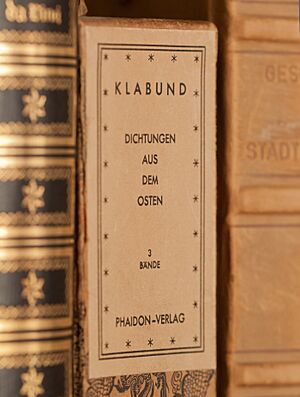Klabund facts for kids
Alfred Henschke (born November 4, 1890 – died August 14, 1928) was a German writer. He is best known by his pen name, Klabund.
Life Story
Alfred Henschke, who later became Klabund, was born in 1890 in Crossen, Germany. His father was a pharmacist. When Alfred was 16, he got very sick with tuberculosis, a lung disease. Doctors first thought it was pneumonia. This illness stayed with him for his whole short life.
After finishing high school with top grades in 1909, he started studying chemistry and pharmacology in Munich. But he soon changed his mind. He decided to study philosophy, language, and theater in Munich, Berlin, and Lausanne. In Munich, he learned about a free-spirited way of life, often artistic, called Bohemianism. He also met the writer Frank Wedekind.
In 1912, Klabund stopped his studies. He chose the pen name Klabund. He wanted to be like Peter Hille, a poet who traveled a lot. His first book of poems was called Dawn! Klabund! The Days Break!. The name Klabund comes from a mix of two German words: Klabautermann (a mischievous spirit from German stories) and Vagabund (meaning a wanderer or tramp).
In 1913, Klabund started working with Alfred Kerr's magazine PAN. He also wrote for Jugend and Simplicissimus magazines. From 1914, he wrote for Die Schaubühne, which later became Die Weltbühne (The World Stage). When World War I began, he was excited about it at first, like many writers then. He wrote several patriotic poems.
Because of his tuberculosis, Klabund was not forced to join the military. During the war, he often stayed in special hospitals called sanatoria in Switzerland. There, he became interested in literature from Asia. He started translating and changing these stories. As the war went on, Klabund changed his mind and became against it. In 1917, he wrote an open letter to Kaiser Wilhelm II in a newspaper. He asked the Kaiser to step down. Because of this, he was charged for speaking out against the Kaiser.
In 1918, he married Brunhilde Herberle. He had met her in a hospital for lung patients. Sadly, she died later that year after problems from a baby born too early. Also in 1918, Klabund's most famous story, the novel Bracke, was published.
In 1920, Klabund wrote a short romantic novel called Marietta. He dedicated it to his girlfriend and inspiration, Marietta di Monaco.
In 1923, he married the actress Carola Neher. Then, in 1925, his play Der Kreidekreis (The Chalk Circle) was first performed in Meissen. This play was based on an old Chinese story. Later that year, the play was a big success in Berlin. (Another famous writer, Bertolt Brecht, later made his own version called The Caucasian Chalk Circle). In the years that followed, Klabund regularly wrote for cabarets, like Schall und Rauch. His simple poems and songs became very popular.
In May 1928, while in Italy, he got sick with pneumonia. This, along with his tuberculosis, was very dangerous. He was taken to Davos for treatment, but he died soon after. He was buried in his hometown of Crossen (now Krosno Odrzańskie). His friend and fellow writer Gottfried Benn spoke at his funeral. Klabund has a star on the Walk of Fame of Cabaret in Mainz.
His Works
Klabund wrote many different things. He completed 25 plays and 14 novels. Some of his novels were published only after he died. He also wrote many short stories, adapted other works, and wrote about the history of literature. Between 1998 and 2003, a collection of his works was published in eight books.
Movies Based on His Work
- Wood Love (1925)



